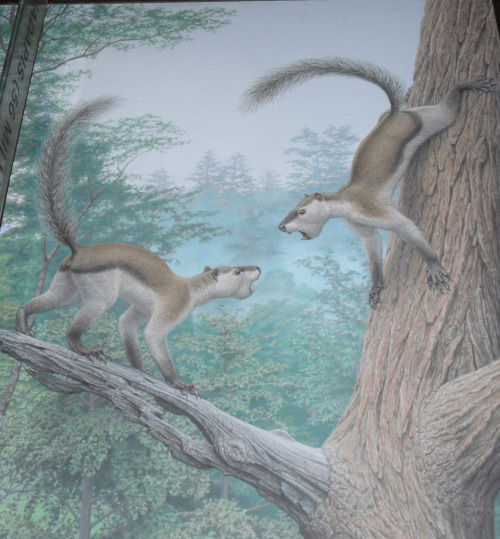PlesiadapisMounted specimen on display at the American Museum of Natural History, NYCReconstruction
PlesiadapisMounted specimen on display at the American Museum of Natural History, NYCReconstruction by Jay MatternesWhen: Late Paleocene to Early Eocene (~ 61 - 55 millon years ago)Where: North America and EuropeWhat: Plesiadapis is a small tree-dwelling mammal that was fairly comment in the late Paleocene of North America and Europe. This ancient mammalian taxon was about the size of a house cat, and though it may look very reminiscent of a squirrel it is a member of the primate family, as part of the larger group Plesiadapiformes. The latest research has shown that Plesiadapis was actually atypical for its namesake clade; this genus tended to be much larger than the average plesiadapiform and was not as well adapted for climbing as its smaller relatives, lacking a hand specially adapted for grasping. Plesiadapis could climb trees, but it would have been an arboreal quadruped, like the living squirrels, rather than a grasping locmotion as seen in most primates today. Another features reminiscent of rodents in Plesiadapis (and this is found in most of its kin) is its enlarged front teeth and the reduction or loss of teeth between these massive incisors and the grinding cheek teeth. Plesiadapis has been reconstructed as a frugivore - meaning its diet was primarily comprised of fruit. As much of North America and Europe was covered with lush sub-tropical forests during its range, Plesiadapis would have had quite a large selection of fruits to feed on. The placement of Plesiadapiformes has been somewhat controversial in the past decade or so. There is uniform agreement that these animals fall somewhere near the group Euarchonta within placental mammals, but exactly where has been much debated. Euarchonta contains not only primates, but also the Scandentia (tree shrews) and Dermoptera (flying lemurs). Some early studies placed plesiadapiforms closer to the dermopterans than primates, but more recent studies tend to find this clade as either the first branches to spring off the primate lineage or just outside of Euarchonta itself, as stem taxa to all three orders. One last point to make things even more confusing! The group Plesiadapiformes? It is probably not a monophyletic (natural) group in reality. It is looking more and more like that some taxa previously grouped within Plesiadapiformes fall closer to living primates than to other taxa within the group. To sum up that confusing mess, Plesiadapiformes are very important in understanding primate evolution, as at least some members of this assemblage of taxa are the first animals on the primate lineage. As this lineage includes me and you there is a lot of study focused on this group right now! Nice to see animals that are primarily paleocene taxa finally getting some attention. -- source link
Tumblr Blog : dailyfossil.tumblr.com
#mammal#primate#north america#europe#fossil#paleontology#geology#evolution#placental#cenozoic#eocene#science#paleozoic

